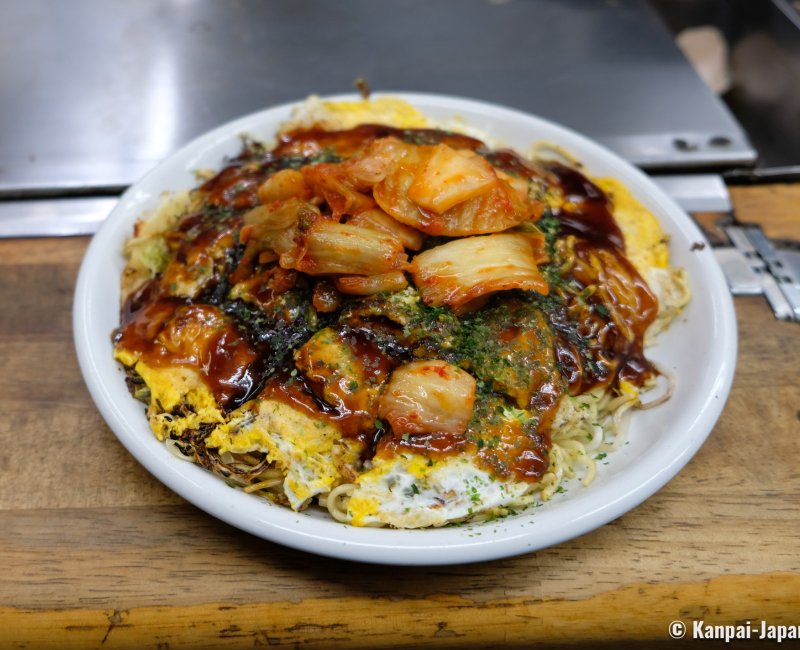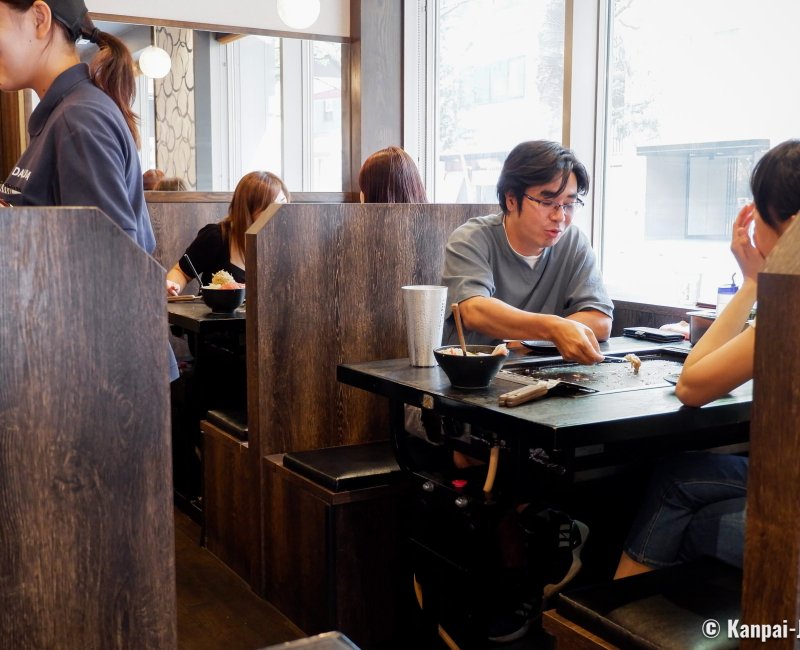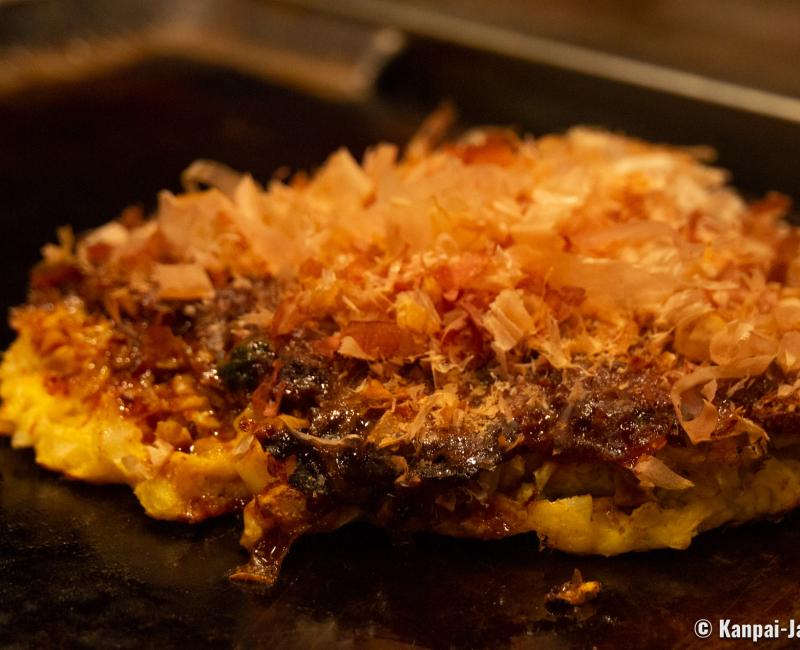Okonomiyaki
The Delicious Japanese Savory Pancake
Okonomiyaki is a thick savory pancake made with wheat flour and filled with cabbage, pork meat and seafood. This hot dish is typical of the daily and festive Japanese cuisine, originating from the Kansai area and Osaka. Hiroshima is also renowned for its okonomiyaki filled with noodles and topped with a fried egg.
Okonomiyaki (お好み焼き), a word that could be translated as "anything you want to cook", is a typical and convivial dish, beloved by the Japaneses, and that may remind of:
- A big pancake filled with vegetables and meat for English culture areas;
- A savory crepe or garnished galette for the French;
- A thick omelet similar to a cabbage tortilla for the Spanish.
The batter is made by mixing wheat flour, an egg and minced fillings. The okonomiyaki batter is cooked on a teppan hot-plate, using a large spatula called hera or kote, and shared between the party seating at the table.
In the 16th century, Buddhist monks would already prepare for their rituals some simple vegetarian wheat pancakes called funoyaki (麩の焼き). Nowadays the funoyaki are considered the precursors of the okonomiyaki, making the Kansai area its official and indisputable place of origins. More precisely, Osaka, and its international port historically trading with Asia and the West, has become over time the cradle of a new wheat-based Japanese cuisine.
Delicious, nutritious and affordable, the okonomiyaki spreads during the post-war period to remedy the lack of rice, especially for the less wealthy part of the city’s population. The dish was created in times of shortage so it is characteristically cheap and hearty; today allow between ¥800 (~US$5.16) to ¥1,500 (~US$9.68) per person in a specialized restaurant in Japan.

Osaka’s traditional recipe
For a traditional okonomiyaki recipe, prepare a batter with wheat flour, dashi broth and a beaten egg. Then add to the batter:
- Fine strips of Chinese cabbage; and,
- If you like it: seafood like very small shrimps or tenkasu tempura flakes for a lighter batter texture.
Spread the mixture on a hot-plate, add on top some fine lard slices, and cook on both sides. Seasoning is added at the end, by spreading layers of:
- Okonomiyaki sauce (a thick brown sauce made of Worcestershire sauce and ketchup);
- Japanese mayonnaise;
- Dried nori seaweed sprinkles;
- Katsuobushi bonito flakes; and,
- Sometimes chopped negi Japanese chives.
The okonomiyaki must be eaten freshly cooked and seasoned, served in a small plate using a small spatula.
The recipe can actually be modified according to everyone’s taste. In Japan, the following toppings are frequently used for garnishing:
- Vegetables such as bean sprouts, corn, mushrooms and kimchi fermented cabbage;
- Other meats, like bacon, minced meat and even chicken;
- Other seafood, such as squid, octopus or oysters according to the season;
- Konjac, to reduce the caloric intake but keep the dish hearty; and,
- Even slices of cheese placed to melt on the top of the okonomiyaki.

Hiroshima-yaki style with noodles
Hiroshima is the other okonomiyaki city in Japan, and the major difference with Osaka’s recipe is the addition of 2 other ingredients:
- A fried egg; and,
- Japanese noodles (soba most of the times).
The cooking is also slightly different as the plain batter is first placed to cook a few minutes on the hot-plate, then the vegetables, noodles, meat and fish fillings are mixed in during cooking. The final okonomiyaki is topped with a fried egg and the usual sauces and seasonings.
The Hiroshima-yaki style is the most common okonomiyaki served during the matsuri in Japan. At the traditional festivals, the okonomiyaki is prepared and cooked at a food stall and served in a small tray to take away; prices start at ¥500 (~US$3.23) for a 1 person serving. Marinated pink ginger is often offered on the side. There is also a version rolled on sticks called hashimaki.

Other Japanese recipes
Depending on the areas in Japan, recipes for the okonomiyaki vary and people like to cook it to suit their taste or adapting it into a local specialty, such as:
- Monjayaki (もんじゃ焼き) from Tokyo’s Tsukishima Island, is a relatively popular variation among the Japanese and tourists. The recipe doesn’t use batter and the filling ingredients are first sizzled on the hot-plate, then mixed to a broth and thoroughly cooked; or,
- Dago (ダゴ) from Omuta City in Kyushu’s Fukuoka prefecture, a giant okonomiyaki that would suit the bigger appetites.

How to cook an okonomiyaki at home
Regardless the country you live in, okonomiyaki are easy to cook at home, especially as you can adapt the recipe to your taste and use a simple frying pan for cooking. The essential ingredients to recreate the Japanese taste, in particular the dashi broth and the sauces, can easily be purchased in Asian grocery stores.
For 1 Osaka-style okonomiyaki (1 to 2 guests) you will need the following ingredients:
- 100 gr okonomiyaki flour (mix of wheat flour and corn starch and / or yama-imo yam);
- 10 gr powdered dashi;
- 100 ml hot water;
- 1 egg;
- 2 large Chinese cabbage or white cabbage leaves;
- Katsuobushi bonito flakes;
- Chopped nori seaweed;
- Okonomiyaki sauce (ex. Otafuku brand) or Bulldog sauce;
- Japanese mayonnaise (ex. like Kewpie);
- Optional: 150 gr fine pork belly slices and / or small cooked shrimps.

To prepare your okonomiyaki:
- Dilute the dashi powder with hot water in a bowl and add the flour and the egg. Mix thoroughly until the batter is smooth, and set aside;
- Finely slice the cabbage leaves so they can cook quickly;
- Mix the cabbage into the batter, as well as the shrimps if you like and mix well;
- For cooking, pre-heat a frying pan or a hot-plate and oil it with a vegetal oil like sunflower oil;
- Pour the batter mix in the very hot pan and try not to spread it too much, the pancake has to be thick enough. Then, add the lard slices and let cook at medium heat during 5 minutes on each side. If the okonomiyaki doesn’t seem cooked enough, cover with a lid and heat another 5 minutes.
Once the okonomiyaki is cooked, transfer it to a plate for seasoning. First brush the top of the pancake with the okonomiyaki sauce, then add the mayonnaise (you can even draw with it). Then, add to your taste nori and katsuobushi, whose flakes are moved by the heat. The okonomiyaki is now ready to eat ; enjoy, itadakimasu!

